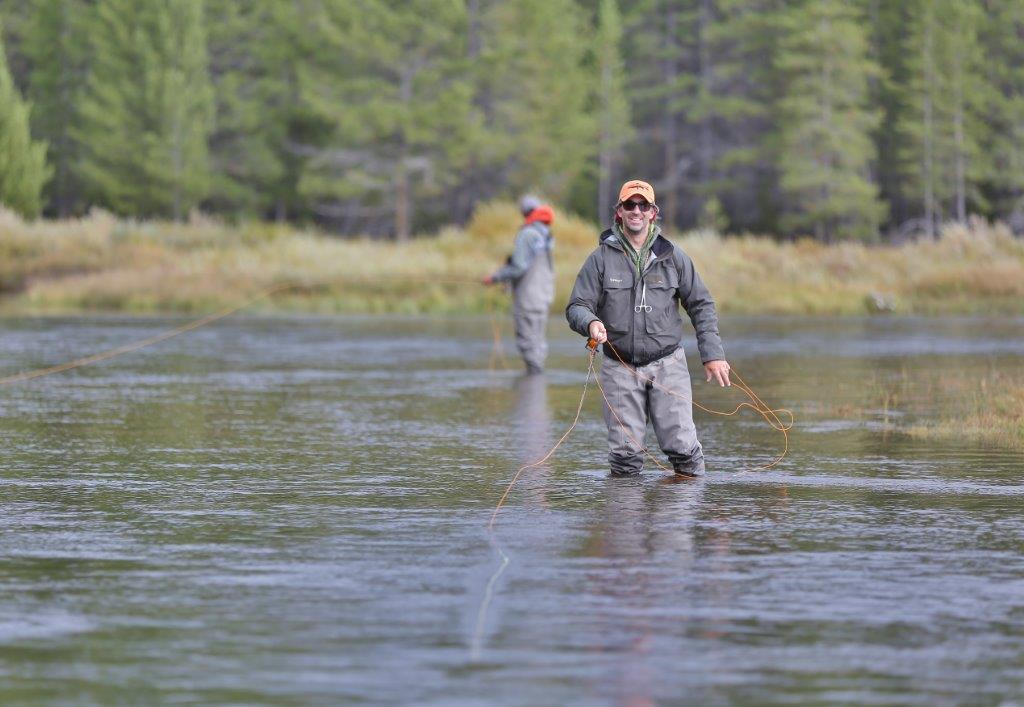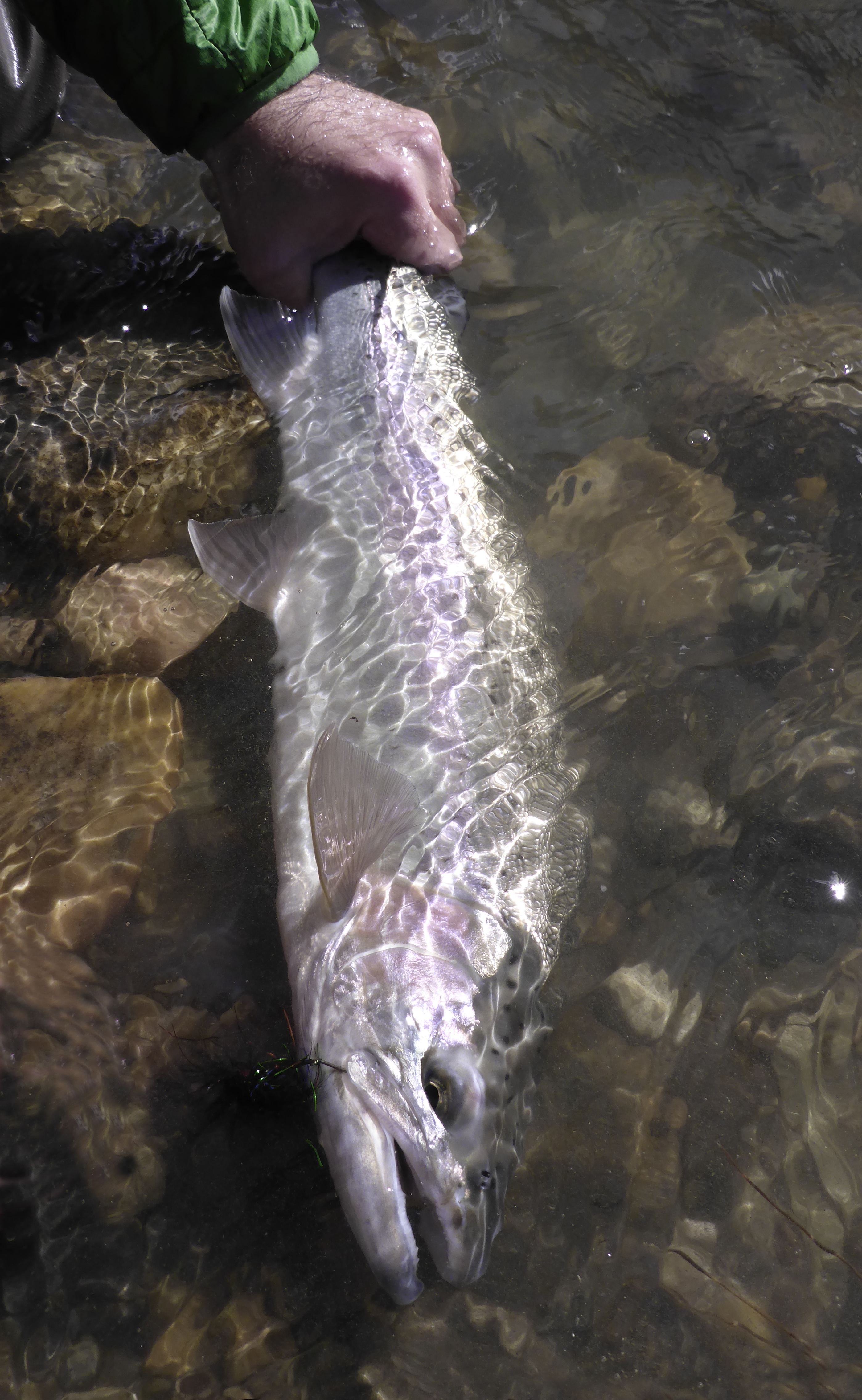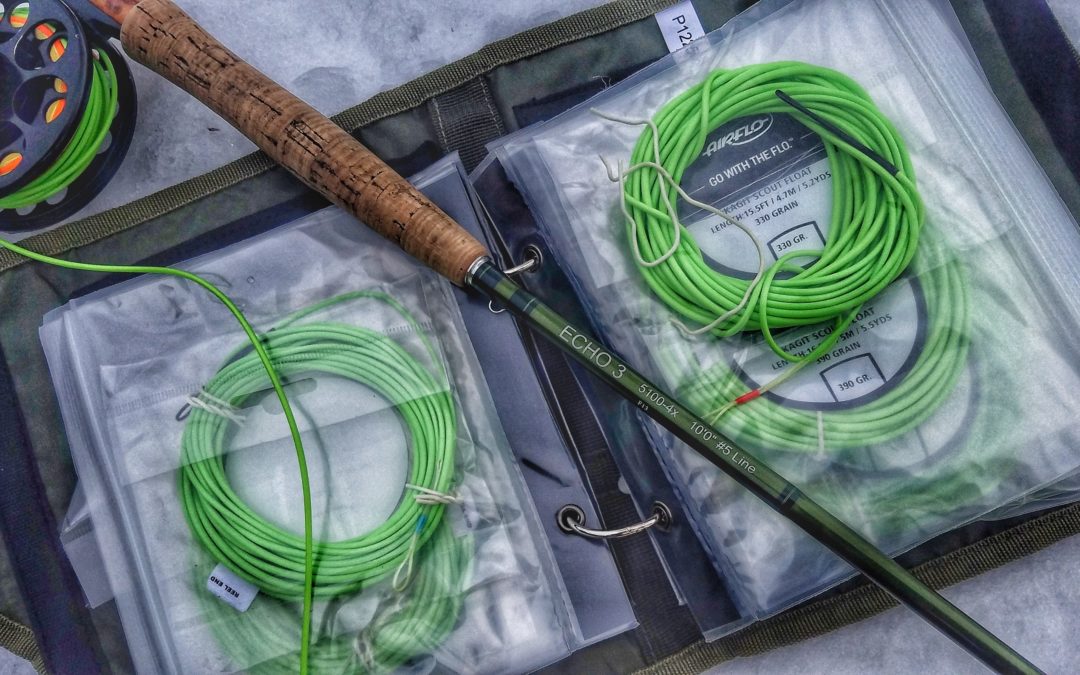In September of 2017, Big Sky Anglers, the fly shop I work for in West Yellowstone, Montana, hosted an event called the West Yellowstone Trout Spey Days. As part of that event, I gave a presentation on the application of Spey principles to everyday trout fishing situations using single handed rods. In preparation for that event, I started asking around about some of these newer, ultra-short Skagit heads. I was looking for help with rod/line pairings, thoughts on capability to throw different tips and flies, and generally, any knowledge whatsoever about how people were applying them to trout fishing here in Montana and beyond. While I did receive some helpful feedback, most of it was related to switch rods, not single hand rods. When it came to trout-specific applications, the response was quieter than the MSU – Bozeman campus on a 2-foot powder day. Crickets.
So, I called up the good folks at Rajeff Sports, told them of my woes, and they were kind enough to loan us a few Skagit Scout demo lines so that we could fool around with them over here in Montana and figure out how they might fit into our trout fishing in time for Spey Days. For their kindness, I promised them some thoughtful feedback, and a blog post about the stuff we managed to figure out. Thus began the project that I’ve come to refer to as my “Scouting Mission”.
What’s the deal with the Skagit Scout?
Here’s a link to the detail sheet on the Airflo website, including rod/line pairings for single hand rods developed with input from the crew at Big Sky Anglers… http://airflousa.com/project/skagit-scout/
I don’t want to spend a ton of time on this, but a Skagit Scout line is essentially an ultra-short version of a typical Skagit head that you might throw on a longer 2-handed rod for trout or steelhead. They run from 13.5 feet long (150 grains) up to 18.5 feet long (480 grains), with the vast majority of the lineup between 14.5 and 16.5 feet long (180 to 390 grains). Designed with the typical Skagit taper scheme, the result is plenty of grains-per-foot to turn over some pretty decent tips, polyleaders, and/or flies. The shortness of the heads also allows them to be used on rods much shorter than typical 2-handed rods, and still maintain a nice, chill, Skagity casting stroke.
The Scouting Mission
SCOUTING MISSION: Code name for the informal process that involved casting and fishing the Scout lines on as many single-hand rods as I could, and sharing the setups with as many anglers as I could in order to get some good feedback. What I really wanted to know going into this was how well the lines match up to the typical fly rods that I already had in my closet. Not trout Spey rods or switch rods – single hand fly rods from 8 to 10 feet long. Ultimately, the goal was to learn, and be able to share what I learned with everyone out there. Aside from that, it was just some good-natured, semi-scientific experimentation disguised as fly fishing. Or was that the other way around?
What did I learn?
First and foremost, the Scout is ridiculously applicable to trout fishing with wet flies and streamers. With the right match of line weight to the type of tip/polyleader and fly you want to fish, these are a super fun and effective angling tool. At this point, I’d reach for a setup with one of Scout lines just about any time I planned to swing flies on small to medium sized water that just seems a bit too small for even a small 2-handed rod. You could easily kill a day by fishing your way upriver before lunch with your favorite 5wt rod rigged with a floating line and a couple of dry flies, and then turn back downriver, swap reels for one with a Scout head on it, and swing your way back to the truck.

I’d certainly reach for one of these lines and a single-hand rod if the anticipated backcast situation is anywhere from severely limited to nonexistent. In September I was fishing with one of our shop guys, and he was using a rod that I had rigged with a Scout and a smallish streamer. At one point I lost sight of him, until I noticed a nice loop flying from out of the trees and bushes on the far bank! He was making some nice, fishable casts from a spot that you’d probably never even consider standing in!
During all this experimentation, I also used the lines on single handed rods plenty of times on water that would probably be better suited to a proper 2-handed rod. Even then, they worked out fine, and I was having fun Spey casting, fishing, and presenting my flies using single-hand rods that I already owned. So, at the very least, these lines are a nice “gateway drug” into the world of Spey for folks not yet ready to commit to a full 2-handed rod setup.
Along the way, I also confirmed what I expected regarding single hand rod length. Longer rods make it easier to Spey cast with single hand rods. 8 footers are short by Montana trout rod standards, and they aren’t the best for casting these Scout lines. You can cast the lines with them just fine, but you lose a lot of that easy flow that Skagit lines are famous for. Standard 9 foot rods were a good match for the Scout lines up to 15 feet in length (150-270 grains) paired with tips/Polyleaders to 10 feet in length. Lastly, 9.5 and 10 foot rods were absolutely awesome. Dreamy. Line management and casting were so easy and effortless that, if given the choice, I’d always reach for one of these slightly longer single handers to pair with the Scout. I use an Echo3 10’ 5wt (which throws really well with 6wt lines as well) for the bulk of my fishing on lakes, and that quickly became my favorite rod to throw the Scout with.
Lastly, I learned that these lines could bring a certain “Fun Factor” to a day on the water. In fact, I’d say that my “winning kits” section below is based almost entirely on the fun factor… but of course, fun and awesome casting and fishing basically go hand in hand for me. What do I mean by fun factor? Examples are the best way to explain it. Example 1 – Unleashing a cast that shoots so clean that it hits the end and dang near bounces the rod out of your hand, which triggers that “OH DAMN!” feeling, and then stripping off a few more pulls of line as a big grin spreads out across your face. Example 2 – Getting absolutely smashed by a big, hot Missouri River rainbow trout while fooling around with Scout pairings on the Echo Gecko kids rod, losing the fish, bursting out laughing, and then looking up and down river hoping that there was someone floating by to see what just happened.

Casting Hints
The Scout heads are well suited to the sustained anchor Spey casts such as the Snap T, Double Spey, Perry Poke, etc. Not surprising, given that they are essentially just shorter Skagit heads. That said, with some finesse (so that you don’t blow your anchor to smithereens) these lines will also work just fine for performing touch and go casts like the Single Spey and Snake Roll. I had a great time working my way quickly downstream on the river flicking a quick series of Single Speys across the likely looking spots. Fast and silent, until a fish grabbed on.
Getting really good distance with these short heads is doable, but requires a bit of attention to detail. Casting trajectory is critical as turnover time with a very short head is limited. A cast directed down to the water or even parallel to the water turns over quickly and then stops shooting. A cast with an upward trajectory, on the other hand, will keep shooting once the head has turned over completely, and score you more distance with these short heads. If there is no wind (or wind at your back) you can really take this to an extreme and aim at a very high trajectory and get some surprising results.
Rigging Hints
Smooth junction loops are nice. Even with a super short head, by using it on a 10 ft or shorter single hand rod there will be more instances than normal of the junction between the running line and Skagit head passing through the rod tip and upper guides. Getting a running line that creates a smooth loop to loop connection with the Scout head will go a long way towards overall happiness.
I liked pairing these heads with either Trout or Steelhead Poly leaders better than I did with level sinking tips. The tapered Polyleaders seemed to clean up and smooth out the aggressive turnover that these short, heavy heads bring to the table.

Limitations and Expectations
I feel like this is something important to mention, because there are indeed some real limitations to these ultra-short Skagit lines set up on single hand rods. Simple physics type stuff. But, if you know what to expect, you won’t end up disappointed.
First, just because it is a Skagit head, doesn’t mean that it is guaranteed to throw chunks of T-17 and a huge lead eyed bunny leech with no problem. It takes grains to move grains, so if you want to huck huge bugs, 150 or even 250 grains isn’t going to do it for you easily. Instead, grab your 7 or 8wt single hander and 300 to 360 grains, and get after it. If you are looking to toss lighter, smaller streamers, or teams of weighted or unweighted soft hackles, then 4 through 6wt rods matched properly with 150 through 270 grain Scouts will treat you right.
Second, it seems like there is a limit to how heavy you can really comfortably go on a single hand rod for Spey casting. Two-handed rods are so great because they make pulling sink tips and heavy flies, and moving heavy lines that much easier. Sure, your Echo3S 1090 will throw that 480 grain Scout, but your arm will probably hate you by lunchtime. I found that going above a 7 or 8wt single hander and 330 grain Scout was really hard on my hand and arm, to the point where I’d likely go to a double handed rod setup when I needed/wanted to throw that many grains, just to reduce my overall ibuprofen consumption.
In the end, if you want to throw a really big tips or really heavy flies a really long way, get yourself a 13’6” 8wt 2-handed rod and a 570 or 600 grain Skagit head. That’s what those are made for.
Winning kits:
9 foot rod – Echo Base 905-4, Scout 180 grain, 8-foot Sea Trout/Steelhead poly leaders, double softhackles, or small/medium unweighted streamers. This is an easy button kit out to 50 or 60 feet for sure. This might be the ultimate Spey gateway drug. $60 line and $12 tip on a $90 rod? Proof that rod line pairings are the real secret in the Spey game, and that talking to people who have tried everything (or most things) can save a lot of time and money in your own quest for Spey Kit Perfection.

10 foot rod – Echo3 5100, Scout 240 grain, Steelhead poly leaders (note the 10’ 5wt Echo 3 is more like a true 6wt), double softhackles, small weighted streamers, medium to large unweighted streamers. This kit was the showstopper at the West Yellowstone Trout Spey Days this past September. I had more questions about this rod and line combo after my presentation than all others combined. Easy casting, easy fishing. Add some nuanced edits to your trajectory along with a haul on the delivery stroke and it plain launches.
Sleeper Bet – Echo Gecko, Scout 150 grain, 5-foot Trout poly leaders, small to medium unweighted flies. Because Spey casting a bright yellow, 7’9” kids rod on a giant river like the Missouri not only turns the heads of every guide that floats by, but is also good for a laugh/fire drill when a 19 inch rainbow climbs on your swung fly. As a side note, a small child could also cast the Gecko and one of these heads using 2 hands with good results. Regardless, make sure your loop-to-loop connection to the running line is really clean with this short rod. The 180 grain head is a bit too long for a perfect pairing here, but it works!
~ Matt Klara is the Media Manager for Big Sky Anglers in West Yellowstone, MT. Matt’s journey into Spey casting and fishing actually began with trout back in 2000, on the Madison River just outside of West Yellowstone. At that point, he was hitting the river with a borrowed 14 ft 8/9wt rod and an old Windcutter line. And by hitting, we mean actually hitting, thrashing, cussing, and occasionally putting one out there well enough to fool a fish (his words, not ours) . Matt’s technique and understanding of two-handed casting and fishing have come along greatly since then, to say the least, and so has the equipment available for trout spey. He left Montana at one point for a 7 year stint in Oregon where 90% of his fishing was done with two-handed rods, but moved back “home” in 2015. Currently residing in Helena with his wife and young son, Matt’s now the guy that folks here at Big Sky Anglers look to for help with their casting, gear selection and more. Whether its trout, steelhead, or salmon, on the two-hander, he is happy to teach and share what he’s learned on his own journey.
Echo team member Evan Burck still gives him grief about that “one time in Alaska” Matt’s knot failed and caused Evan to break off a big steelhead. Matt claims he redeemed himself with his contribution to another steelhead that Evan landed – invalidating the prior lost fish. But Evan says the sharp pain of losing an Alaskan steelhead never dies, and lying in bed at night, he still wonders: “If only Matt had used an Improved Clinch Knot instead of a regular Clinch.” 😉

Recent Comments